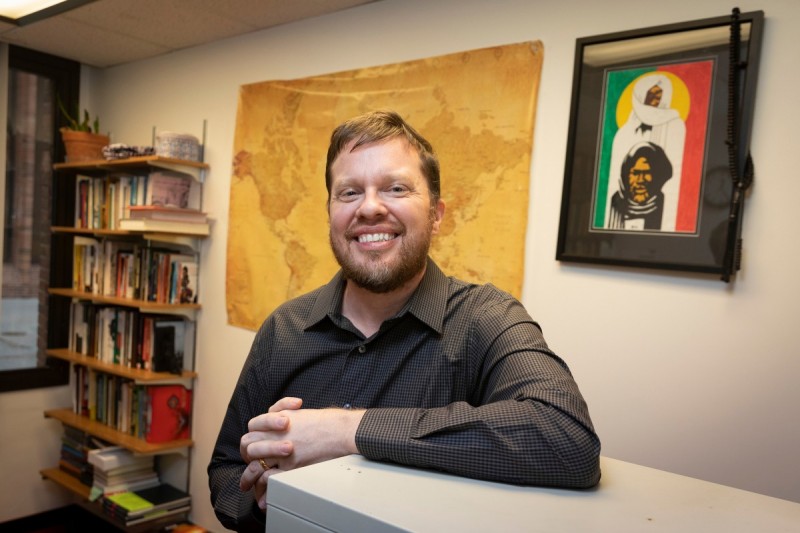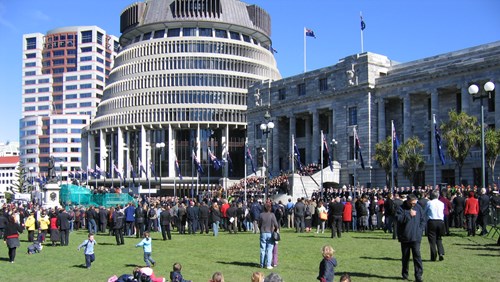
Winds Of Change: New Book Explores Intertwined Past Of East Africa And Persian Gulf
Since ancient times, the winds have propelled mariners from the Arabian Peninsula to east Africa and back again, shifting in tandem with the monsoon season. As a result, the region have close historical ties, from the spread of Islam to the building of modern nation-states.
In his book Zanzibar Was a Country: Exile and Citizenship between East Africa and the Gulf, Binghamton University Associate Professor of Africana Studies Nathaniel Mathews traces the history of a Swahili-speaking Arab diaspora who made their way from Oman to East Africa and back. He was recently awarded the 2025 Monsoon Book Prize in History for his work, with judges describing the book as “highly original,” “intensely interdisciplinary” and written in a gripping yet analytical style.
The Swahili Coast stretches from southern Somalia to northern Mozambique and includes both Kenya and Tanzania. After the Zanzibar Revolution of January 1964, Tanzania was formed that April from the merger of Zanzibar with neighboring Tanganyika, a combination reflected in the country’s name.
Mathews traces the transregional history of exiles in the wake of the revolution, and how their stories play into a larger story of nation-building and development in both East Africa and the Persian Gulf. Also playing a starring role is the rise of the Gulf’s petroleum economy, which led to the in-migration of hundreds of thousands of people to work in the industry.
“It also raises this issue of the boundaries of the nation-state and who gets to belong to that nation-state, and on what basis,” he said. “It remains one of the most contentious political issues of the 21st century. There are broader regional cultures that transcend these borders.”
Located on an archipelago in the Indian Ocean, Zanzibar has a lengthy history. Refugees from religious warfare in the Islamic caliphate migrated there, fleeing persecution. The Omanis who ended up in Zanzibar were members of a minority madhhab, or school of Islam, known as Ibadi.
The islands were later governed by the Sultanate of Zanzibar and Pemba from the 1840s until 1856, when Zanzibar became its own sovereign state, governed by an Omani-descended lineage called the Busaidis. The history of this state is key to the debates about the region’s cultural and national identity: Is Zanzibar primarily Arab or East African?
“Decolonization in Africa was challenging minority rule. It was seen by some political leaders in East Africa as anachronistic to have an Arab minority dynasty ruling over an African majority society,” Mathews explained.
Zanzibar became a protectorate of Britain in 1890, although the sultanate remained in place. After the protectorate ended in December 1963, Zanzibar briefly became an independent nation. The revolution began a month later, with an African paramilitary group overthrowing the government and sending the last sultan into exile.
The revolution’s Arab-descended exiles didn’t immediately return to Oman but went to other Gulf destinations such as Dubai and Doha or southern England, where the exiled Zanzibari sultan made his home. In 1970, Oman’s new sultan, Qaboos bin Said, issued an explicit invitation for the diaspora to return home and engage in nation-building.
The exiles responded with enthusiasm, although some families were cautious, with members trickling back a few at a time to make sure that the country was safe.
“In this way, the early Omani state used returnees from East Africa to indigenize the national bureaucracy, so that the returnees from East Africa ended up replacing British expatriates who were predominant in many positions within the state bureaucracy and the state oil company,” Mathews said.
Tensions emerged; many returnees weren’t fluent in Arabic, and there was occasionally a backlash against speaking Swahili in public spaces. The arrival of new family members from abroad also provoked complicated questions about property and inheritance.
Cultural differences emerged, too, especially in regard to attitudes around gender and gender-mixing. At the time, the women of Zanzibar were among the most highly educated in East Africa and many had experience working in professional workplaces with men. Omani society, by contrast, was more culturally conservative and unaccustomed to having women in public roles.
“The sultan was trying to encourage the education of women, and to have women participate in the process of nation-building,” Mathews said. “But social tensions did occur.”
When we look at the history of decolonization and nation-building, it’s important to recognize that these processes didn’t occur in isolation from each other, Mathews said.
“The process of building the nation in Zanzibar, even though it led to the union with Tanzania, is very entangled with the process of making and building the nation in Oman,” he said. “You can look at the history of any number of Indian Ocean countries and find these regional entanglements of decolonization that are important to understanding the shape that the nation assumed after independence.”
https://www.binghamton.edu/news/story/5524/winds-of-change-new-book-explores-the-intertwined-past-of-east-africa-and-the-persian-gulf


